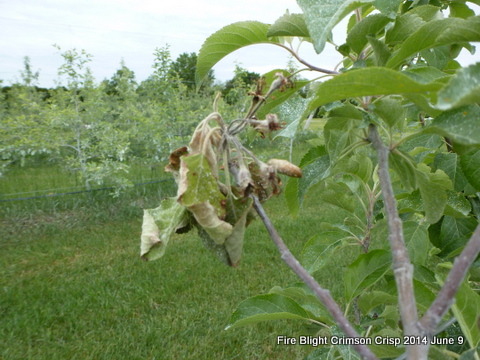June 24, 2014
Summer diseases: For management of sooty blotch, fly speck, and black rot on fruit, growers should maintain fungicide protection on apples after each approximately 200 hours of accumulated leaf wetness. That means that after a spray is applied, begin accumulating leaf wetness hours and apply your next fungicide spray before the next 200 hours of wetness occurs. Remember that 1″ of rain washes off about one half of fungicide residue, and after two inches, you can assume that there is nothing left. Fungicide options for summer disease management can be found on pages 151-152 of the New England Tree Fruit Management Guide. Mary Conklin from University of Connecticut Extension recently summarized fungicide options for summer diseases of apples:
“1. Topsin M + Captan: Standard treatment for SBFS and summer fruit rots, but late-season applications of Topsin M are not acceptable for some markets, and the Topsin M label limits applications to a total of 64 oz/A/year. Most growers are finding that Topsin M must be applied at 12-16 oz/A for good results, so that means that this combination can be used no more than 4 or 5 times per year.
2. Captan plus a labeled phosphite fungicide: This combination is just as effective as Topsin M + Captan against SBFS, but the phosphites have little or no activity against black rot. Thus, with this combination, control of black rot and other summer fruit rots is dependent on the rate of Captan that is applied.
3. Inspire Super + Captan: Inspire Super is very effective against SBFS, but like the phosphites, it is less effective than Topsin or strobilurins fungicides for controlling fruit rots. Using Inspire Super during summer may also contribute to selection pressure for DMI-resistant apple scab if primary scab was not completely controlled, although that assumption remains unproven.
4. Flint + Captan, Pristine + Captan, and Merivon + Captan all provide nearly equivalent control of SBFS and summer fruit rots. The latter two have better long-term residual activity than Flint and are therefore preferred for the last spray in August or September, when a long residual is needed to cover the gap until harvest. All of these combinations include strobilurins fungicides (FRAC group 11) and have label limitations on the total number of applications per season and /or the number of sequential applications that are allowed.
5. Fontelis does not have much activity against SBFS and is not recommended during summer.
6. Captan applied alone can be effective if applied at higher rates (4-5 lb/A of Captan 80W) and at no more than 14-day intervals. However, mixing Captan with one of the fungicides mentioned above generally provides better results.”
Apple scab: By now you should have a good idea of whether or not you have scab in your orchard. If not, good for you, scab management is done for 2014. If you do, be sure to maintain residual fungicide coverage until harvest. Any of the above listed summer fungicide materials will protect fruit and developing foliage from new infection from secondary inoculum.
Fire blight: Blight has been appearing in the UVM orchards this season and we have been diligent in cutting it out, as should you if you see it. In blight-affected orchards, application of streptomycin should be considered within 24 hours of a hail storm, but otherwise, no strep should be applied after strikes are observed to reduce the likelihood of the bacteria developing resistance4 to the material. If you have a problem with fire blight in your orchard, trust me- you do not want strep resistance.
Insects:
Codling moth is the primary summer insect of concern right now, so an insecticide in the next spray may be warranted in orchards where this pest is a problem.
Apple maggot traps should be hung any day now and monitored at least weekly. Traps should be placed at the at least four per block in the perimeter of the orchard to catch migrating flies. The threshold for management is one accumulated fly per trap on baited spheres and five accumulated flies per trap on unbaited spheres.
Terence Bradshaw, UVM Tree Fruit and Viticulture Specialist




